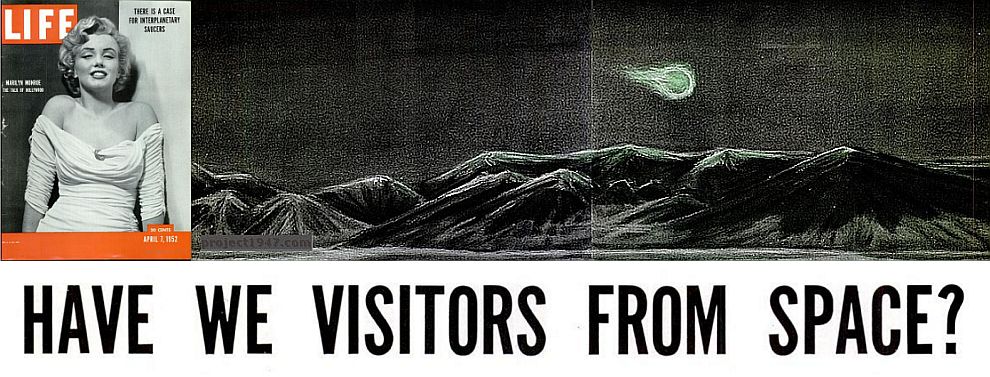

TWO extraordinary documents found in the US Air Force Directorate of Public Relations archives belie the contention that government officials always considered the UFO problem as nothing more than a nonsense issue which only required minimal effort and public assurance that everything was under control. Recounted within these documents are the briefings of a researcher for LIFE Magazine — one of the most powerful media outlets at the time — wherein an Air Force general officer discloses that the USAF considered trying to shoot down a UFO with a missile.
The importance of these findings should not be lost in the sometimes cryptic and intricate maze of confusing official military nomenclature and procedures. Some clarity about the significance of the material may be read at the conclusion of this article.
The first step in the official overture from the US Air Force to involve mainstream press interest in the UFO subject was taken at an off-the-record meeting in the Pentagon on February 27, 1952. There LIFE magazine researcher Robert Ginna met with the number two man in the USAF Directorate of Intelligence, Brig. Gen. William M. Garland.
The resulting article "Have We Visitors from Space?" in the April 7, 1952 issue of LIFE magazine vaguely alluded to the shoot-down plan, saying that "interceptions" would be attempted and "if the opportunity offers, attempts will be made to recover such unidentified objects."
The LIFE article triggered worldwide publicity and interest in UFOs. It generated comments from the public and within official channels on how to best investigate UFOs, including using instrumentation to gather scientific data utilizing the ideas the Air Force expressed in the article.
Tom Tulien of the Sign Oral History Project requested an interview with Robert Ginna in 2009 concerning the April, 1952 LIFE magazine article "Have We Visitors from Space?" Unfortunately, Mr. Ginna declined due to scheduling issues and his feeling that the events were all well in the past.
The magazine article stands on its own merits, but exact circumstances about the origin and history of the research for the article will probably never be known.
Besides these two documents, official records do shed light on some of the aspects of the creation of the article. It is also possible to place some of the events in the context of known UFO history.
The official responses and activities planned for Mr Ginna's proposed research mission were documented in official sources. These ranged from the formerly Top Secret 1952 USAF Directorate of Intelligence history, Project Grudge/Blue Book Status reports edited by Capt. Edward J. Ruppelt, and Ruppelt's unofficial account of his tenure at Project Blue Book, his 1956 book, The Report on Unidentified Flying Objects. Other references were located in the USAF Public Information files on UFOs 1948-April 1952.
As researcher Brad Sparks has pointed out, LIFE magazine's research probably began in mid-1949, but went dormant for a time after TRUE magazine "scooped" them with Keyhoe's sensational article "The Flying Saucers Are Real," in December 1949.
Reprising the title of his popular TRUE article, Donald E. Keyhoe's 1950 book, "The Flying Saucers Are Real", alludes to another major magazine's competitive research efforts and the pressure to publish first. There are also vague allusions to LIFE doing some research at this time.
The research for the LIFE article began or resumed sometime in late 1950 or early 1951. During Ginna's investigations he gained extraordinary access to US Air Force and Atomic Energy Commission (AEC) installations and personnel. It would seem that some high ranking individual or individuals facilitated these visits, heavily influenced by LIFE's worldwide reputation.
Many UFO researchers point to Brigadier General William Garland as the likely facilitator here. Garland came to the Directorate of Intelligence (DI) in November 1951 and within a few months became keenly interested in the UFO problem when his superior, the Director of Intelligence, Major General Samford expressed an interest. However, this does not explain who might have aided Ginna prior to Garland's tenure at the Directorate. Such access would probably require the influence and authority of at least a Lieutenant General.
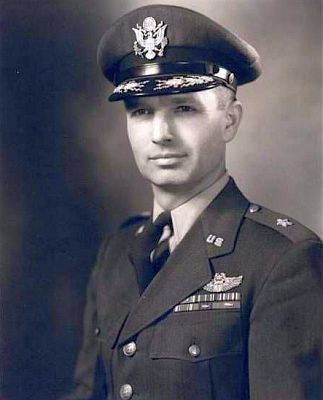
Brigadier General William Madison Garland
The USAF Information Office made arrangements for Mr. Ginna to visit Air Technical Intelligence Center (ATIC) at Wright-Patterson Air Force Base on 22 June 1951. Ruppelt described the visit in his book, relating that it was obvious that the intelligence people who briefed the reporter did not impress him with their knowledge or command of the subject.
Ruppelt recounts in his book that the official attitude to UFOs began to change after Ginna's visit. In September 1951 a military UFO incident involving radar and aircraft at Fort Monmouth, New Jersey became public knowledge. A review of the incident at the Directorate of Intelligence (DI) revealed that both the investigation and analysis of the incident were poorly conducted and inadequate to the task. A more thorough and revitalized investigation was ordered by the Director of Intelligence, Major General Cabell, on October 2, 1951.
The "reborn" Project Grudge was formed and reorganized on October 22, 1951, with a brand new project chief.
Unlike Project SIGN, none of the regular staff members at ATIC were appointed to the project. Instead, a newly graduated aeronautical engineer and enlisted veteran of World War II who was a recently commissioned First Lieutenant in the US Air Force Reserve was designated to head the new project — Edward J. Ruppelt.
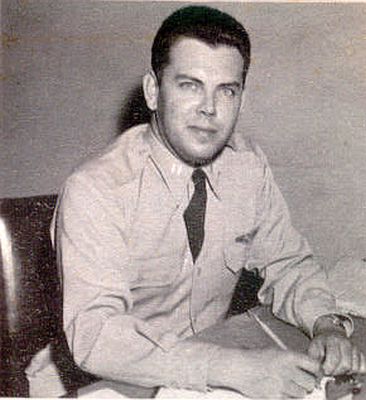
Captain Edward J. Ruppelt
Ruppelt was assigned to a major's billet which was highly unusual considering his rank. He arrived at ATIC in January 1951 but did not receive an interim Top Secret clearance until January 1952. Perhaps his selection indicated that no "old timer" civilians wanted to be associated with the UFO project.
Those who had been assigned to intelligence at Wright-Patterson knew some of the analysts on the original project had been terminated, with the last to go being Alfred Loedding, "the initiator of Project Sign." (After Loedding's separation from the Air Force, he easily found work with the Navy and later returned to Wright-Patterson in another capacity.)
New policies and directives on UFOs started to flow out of AF Intelligence Directorate's office in Washington. It was decided that copies of UFO reports would be sent to the Navy, Army, CIA and other agencies.
One such new action in December 1951 involved Mrs. Helen Barber, managing editor of the classified internal publication, "Air Intelligence Digest" at DI, who began a study of UFOs and the Air Force UFO project for the Directorate. Her project was completed in June 1952 and has yet to be located. She was involved in several UFO investigations and other such activities at DI.
Between 4 and 14 January 1952, Mrs. Barber traveled on Temporary Duty (TDY) from DI to ATIC to gather material on UFOs. Ruppelt does not mention her visit in his status reports.
Sometime in early 1952 Ruppelt did prepare an article on unusual objects reported in the sky before 1947 for the Air Intelligence Digest.
He made a number of trips to the Pentagon on July 21-22 and 28-29, to coordinate plans for the article. (Among other things during these visits, he was confronted by the two weekends of the Washington National Airport sightings. Strangely, he was initially shut out of the investigations of the Washington National incident.) Ruppelt's article was never published, but the draft is in the Project Blue Book files.
While on her January visit to ATIC, Brig. General Garland further tasked Mrs. Barber and others to summarize German experimental and prototype unconventional aircraft developed during World War II and their possible use by the Soviets. The project started on 9 January and was to be completed by 25 January.
This was part of a bigger effort involving UFOs that Brig. Gen. Garland wanted, including the dispatch of three teams each from the Air Defense Command (ADC) and ATIC to take radar and visual photographs of UFOs in places where there had been numerous reports. (The results of this tasking is unknown.)
On January 29, 1952 two different incidents occurred in the Korean war zone. Two B-29 bombers, one flying over Wonsan and the other over Sunchon, observed bright orange, globe-shaped objects moving parallel to their planes. The report of two independent sightings by crew members of two different bomber squadrons at two different locations arrived at ATIC as a Secret message.
On the 1st of February, a request was sent for more information forwarded through DI in Washington to the Far East Air Force.
On the 4th of February, Lt. Col. Ray W. Taylor at ATIC sent a message to Brig. Gen. Garland (AFOIN-A), Assistant for Production at DI. Taylor suggested several possible solutions for the Korean sightings including "fireballs" or "foo-fighters", a phenomenon which he said had never been completely explained.
The Air Force and the new Project Grudge were not prepared for the publicity resulting from such a major UFO incident and was caught by surprise when someone leaked details of the Korean sightings to the press. On the 19th of February the story appeared in the newspapers without the usual Air Force denial that there was anything to UFOs. The press, in fact, pointedly called the public's attention to the lack of such denial.
At this time, new public information policies on UFOs and the Air Force revitalized investigations consisted of tentative discussions and ideas with no finalized directives. The furor caused by the leak of the sightings from the Korean war zone caused decisions for the release of public information to be made on the fly.
A dispatch from Tokyo on the 20th of February reported B-26 crews seeing “strange looking orange globes” in night flights over Korea. Air Force spokesmen in Tokyo and in Korea refused comment, stating the information was "classified." (No such B-26 reports are found in the Project Blue Book files.)
The Alsop brothers were quick off the mark with a column, soberly covering the incidents and possible security implications.
On the 21st of February Senator Richard B. Russell, Chairman of the Senate Armed Service Committee, wrote to the Secretary of the Air Force requesting a full report on the Korean UFO sightings.
The 22nd of February edition of the Pacific "Stars and Stripes", the official newspaper published for troops overseas, contained a statement from Lieutenant General (later General) Otto P. Weyland about the B-29 "globe" sightings. In a dispatch from Tokyo, dated February 21, General Weyland stated that “no conclusive evaluation had been made at the present time” about the sightings. He added that the reports made by aircrews of observations made during missions provided important information on enemy tactics and equipment.
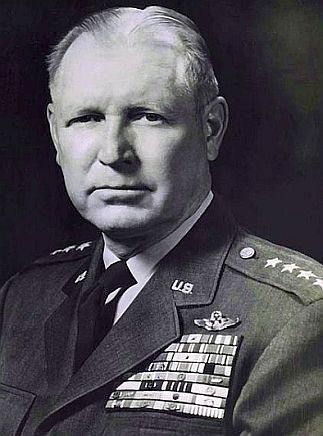
Lieutenant General Otto. P. Weyland
On the 25th of February, Senator Russell's letter was forwarded to the Director of Intelligence with a request for a reply before March 4. Mrs. Barber found herself among the DI personnel who were to come up with a response for the Senator. Ruppelt, while actively involved in gathering information on the Korean incident, was excluded from the analysis and answer for the Senator.
The investigation, the analysis, the public statements, and official answer to the Senate Armed Service Committee showed the somewhat confused situation which the Korean incidents had caused. In the midst of all this official turbulence, Robert Ginna commenced his visit to Air Force headquarters on 25 February 1952.
From the Memos we know that Mr. Ginna — with the assistance of Brigadier General Sory Smith, Director of USAF Office of Information — met with General Joseph F. Carroll, Deputy Inspector General, and Director of Special Investigations. It is not known what was discussed, but the Office of Special Investigations (OSI) had maintained a professional attitude towards UFO investigation when the efforts by most other Air Force agencies were dismissive and investigations could be characterized as minimal. Ginna was most interested in the "green fireball phenomena" in the southwest.
He had previously met with Dr. Lincoln LaPaz, meteoriticist, at the University of New Mexico.
Dr. LaPaz had volunteered to work investigating UFOs and Green Fireballs with the 17th District OSI, formerly headed by Lt Col. Doyle Rees.
(Dr. LaPaz personally witnessed green fireballs and was the top astronomer referred to in LIFE Incident #2) Through General Carroll's office Mr. Ginna was allowed to interview Col. Rees who was then assigned to Washington, D. C. Ginna requested that Lt. Col. (later Major General) Dewitt R. Searles get him an appointment at Air Technical Intelligence Center (ATIC) at Wright-Patterson Air Force Base, Dayton, Ohio. Brigadier General William M. Garland, Assistant for Production, Directorate of Intelligence, coordinated the proposed visit and also scheduled an interview with Mr. Ginna before he left Washington.
Ginna met with General Garland on the morning of the 27th of February. Mrs. Barber and Lt. Col. Searles were also present. General Garland said he was interested in fostering a more positive attitude towards UFOs, inviting accounts from qualified observers.
Brig. Gen. Garland urged LIFE to hold off publication until more conclusive evidence became available, but it was obvious that Mr. Ginna did not intend to follow this suggestion. Brig. Gen. Garland did suggest an exchange of information with LIFE. He also revealed that the Air Force was issuing collection instructions, was planning to equip all-weather interceptors with cameras to photograph UFOs, and might make an attempt to shoot one down with a missile.
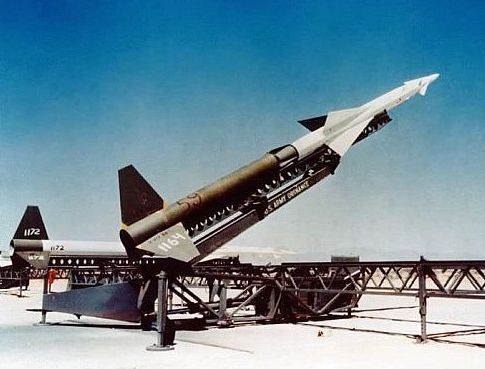
While the Army Nike-Ajax had undergone testing in 1952, it would not be deployed until 1954. It was further along in the procurement cycle than the Air Force missiles, but unless some extraordinary special preparation were accomplished, it was not ready to try to shoot down a UFO in 1952, as revealed in Brigadier General Garland's briefing of LIFE magazine researcher Robert Ginna in February 1952.
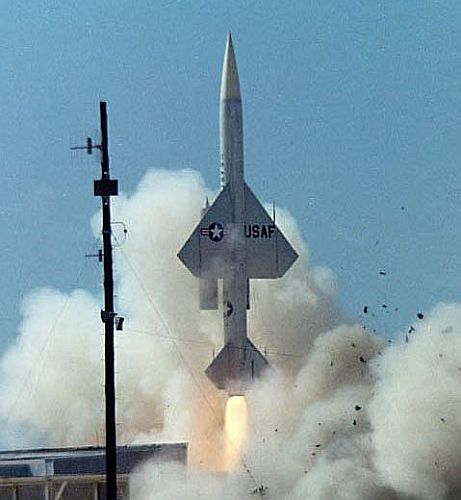
The Air Force was developing a long range radar-guided missile of its own, the Bomarc, which at the time of the meeting with Ginna was still months away from its first propulsion test firing in September 1952. Several years of development followed and the first USAF operational Bomarc squadron — 46th Air Defense Missile Squadron (ADMS) — finally came online on 25 March, 1959.
On March 3rd Ginna visited ATIC and met with Ruppelt. He brought with him sighting reports by highly qualified observers. LIFE magazine had representatives all over the world who could send in reports which they might be able to exchange with the Air Force.
Time magazine used some of the same material Ginna planned to use in an article in its Science section about the Korean B-29 incidents. Time also published the address of the Civilian Saucer Investigations in Los Angeles (CSI-LA), related the activities of Dr. LaPaz and White Sands' official interest in the green fireballs, and the Frank Scully story of a crashed saucer.
While the issue was cover dated for March 3rd, subscribers by mail usually received TIME and LIFE before the newsstand date.
On 5-10 of March Mrs. Barber visited the Time and Life editorial representatives in reference to articles on the subject to be published by the magazines. On 5th March, Lt. Gen. Weyland gave an interview published in the European "Stars and Stripes" of 6 March in which he implied that Russian pilots were flying in combat in Korea. The military, of course, was well aware they were fighting Russian pilots, but it was policy not to make it public. Lt. Gen. Weyland, who served with Patton during World War II, skirted the issue while indicating that that was the case. He also expressed skepticism over the earlier explanations that the cause of the B-29 sightings were the glow of aircraft exhaust, the answer given the Senator Russell.
On the 8th of March, Secretary of the Air Force answered Senator Russell's letter which included the DI conclusion that the B-29 crewmen had seen the exhaust glow from Communist aircraft. The conclusion was signed by General Nathan F. Twining, Vice Chief of Staff.
On 14 March two Navy planes flying 50 miles apart between Guam and Pearl Harbor, Hawaii, encountered two UFOs. The first plane, carrying Secretary of the Navy Dan Kimball, had two fast-moving discs approach and circle the plane twice before disappearing to the east. The next plane carrying the Chief of Naval Research, Arthur Radford, also encountered the discs which circled the plane and disappeared. Only the crews observed the UFOs, not the high-profile passengers. The sighting is not in the Project Blue Book files and was not made public until May of 1952.
In the aftermath of the incident, Secretary Kimball ordered a separate Navy UFO investigation project be instigated. The details and findings of that effort have yet to be located.
The LIFE magazine article was published on the 3rd-4th of April with the cover date of the 7th. It received coverage in hundreds of newspapers worldwide. ATIC received 110 letters as a result of the article while LIFE magazine itself had 700 letters. The Air Force archived many of these letters, eventually filling two microfilms. Since "foo-fighters" were mentioned in the article some veterans sent along their accounts, a selection of which are published here on Project 1947. Letters from other magazine articles are also represented on the microfilms. Incidents from 1952 and back to the 19th century are recounted in this collection.
Contributors to this essay: the late Robert Todd, information found utilizing a research grant, "UFOs and Government" provided by the Louis Farish Foundation, Robert Powell, Barry Greenwood, Brad Sparks, Isaac Koi, Dr. Michael Swords and John Stepkowski.
— Jan L. Aldrich
Footnote:
Excerpts from the formerly Top Secret History of the Directorate of Intelligence for 1952:
Mrs. Helen Barber, managing editor of the Air Intelligence Digest,
visited Air Technical Intelligence Center, Dayton, Ohio, 14 to 24
January 1952, for the purpose of coordinating intelligence matters
relative to report but [sic] unidentified airborne objects; she
later proceeded to New York, 5-10 March for the purpose of
discussing and coordinating matters with editorial representatives
of LIFE and TIME magazines relative to articles scheduled to be
published by these agencies concerning the above mentioned
phenomena.
(The reference cited is "TDY (Temporary Duty) Records,
Administrative files, Estimated Division")
From Appendix III, Historical Report of the Deputy Director for Estimates of the 1952 History of the Director of Intelligence (formerly Top Secret)
Mrs. H. H. Barber, managing editor, [Air Intelligence Digest] complete in June [1952] the special research assignment in reference to 'Project Bluebook' dealing with unidentified aerial objects which she had begun in December 1951.
(The reference cited is "Historical Report Fiscal Year 1952, Current Intelligence Branch, by Colonel Geoerder. [not seen])
We did try to find more about Mrs. Helen Barber, but like the Delaware Saucer Associates, an early UFO organization which Ruppelt did not like much, and the Flying Saucer Research Center of Amarillo, another early organization operating about the same time as Ruppelt's tenure at Project Blue Book, most leads have led to a dead end. — J.L.A.
Some Final Thoughts
A friend read this article. "What is the take away? I think I can see it, but some of what you are talking about is just too 'inside baseball' for me. Could you give me a few main points and then some shorter bullet points, or a few sentences so I can see what you're getting at?"
This is an entirely reasonable request. The path to understanding the history of the official handling of the UFO subject can be complex and beyond what many are familiar with, especially those who have read little background on the topic.
Here, then, is what I consider the major "take aways" from the LIFE magazine article:
First, the revelation that the Air Force was considering using a missile to shoot down a UFO. This certainly places the subject in a new light, far from the marginal nonsense problem as portrayed by some historians. Such a plan presumed they were not dealing with some "hallucination" or "optical illusion," but a solid, material object which could be shot out of the sky!
If the idea were more than a mere pipe dream, one would expect to find documentation discussing the possibility of implementing it. The most likely places to look would be the USAF Directorates of Intelligence, and Operations, the Assistant Chief of Staff for Operations, Research and Development activities, and the Ordnance Department — for which we only have a few hints of their interest and activities. Depending on how widely this idea might have been considered, records could also be located in organizations outside the Air Force.
Second, LIFE magazine did years of research on the UFO problem. Bob Ginna showed up at the Pentagon when Air Force Headquarters were in the midst of a hullabaloo over the leak of the twin UFO sightings over Korea, and a still unsettled Air Force public relations policy on how to handle UFO inquiries from the media. Ruppelt said the LIFE magazine piece was the best researched article written, except for the conclusion. LIFE had done much more research than appeared in its discussion of the ten incidents featured in its magazine article, and continued to investigate the subject for a number of years thereafter, especially during 1957. Unfortunately, none of this material is available to the public.
Third, after seven decades, UFO history remains incomplete, with many gaps compromising the amount of research material available for serious inquiry. Early UFO history consists of several books relating, in some cases, third and fourth-hand information. Much of the documentation still eludes historians. One of the most relied on sources is Edward Ruppelt, first chief of Project Blue Book. Even though an insider, Ruppelt only knew of many events preceding his tenure through second or thirdhand accounts.
New historical discoveries often find their way into the current history, shoehorned into the existing narratives without taking proper account of what they really reveal. The plethora of missing documents and reports include:
• Reports on unconventional German aerial vehicles which might been utilized by the Soviets.
• Results of ATIC and ADC teams dispatched to UFO hotspots.
• Mrs. Helen Barber's UFO study.
• Night-flying B-26 encounters with strange lights similar to the B-29 incidents reported in the press on 20 February, 1952.
• The official report of the UFOs buzzing aircraft carrying the Navy Secretary and other high ranking officials over the Pacific.
• Investigations and reports compiled and analyzed by the Office of Naval Research during the Navy's short-lived UFO project.
Fourth, Ruppelt, the newly minted Project Blue Book chief — the man who shook down former Project SIGN and Project Grudge members to obtain the UFO reports in their desks, who went to the Pentagon and hunted down UFO reports that had not been sent to ATIC, and who had a question on UFO encounters for debriefings of returning Korean aircrews — admitted that he knew almost nothing about unusual aerial encounters during World War II.
Loren Gross characterized Ruppelt as "the UFO data collecting superman," yet in both the LIFE and LOOK magazine articles, his book, and in his personal papers, Ruppelt professed ignorance of the World War II foo-fighters phenomenon. Had Ruppelt been more aware of the historical pedigree of UFOs, perhaps his investigations may have encompassed a wider field of inquiry.
The answers to the questions raised in this article are ripe for discovery, and the search will continue.
— Jan L. Aldrich
|
|
|
|
|